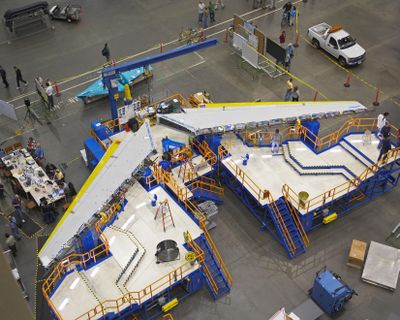Dreamliner deferred: Design flaw delays Boeing 787

SEATTLE – The wing damage that grounded Boeing’s new composite 787 Dreamliner occurred under less stress than previously reported – and is more extensive.
An engineer familiar with the details said the damage happened when the stress on the wings was well below the load the wings must bear to be federally certified to carry passengers.
In addition, information obtained independently and confirmed by a second engineer familiar with the problem shows the damage occurred on both sides of the wing-body join – that is, on the outer wing as well as inside the fuselage.
The structural flaw in the Boeing design was found in May during a ground test that bent the wings upward. Stresses at the ends of the long rods that stiffen the upper wing skin panels caused the fibrous layers of the composite plastic material to delaminate.
The damage at the end of each of the 17 long stiffening rods, called stringers, on each wing’s upper skin happened just beyond the aircraft’s “limit load,” which is the maximum load the wing is expected to bear in service.
Last week, the Seattle Times mistakenly reported that the damage occurred later in the test, just beyond “ultimate load.” That is defined as 50 percent higher than the in-service limit load and is the Federal Aviation Administration’s test target. The tearing at the end points of the stringers well before the wing reached ultimate load means the problem is worse than suggested last week.
Because the wing test fell short of the ultimate load target, the plane could have flown only under restrictions that would have severely limited the usefulness of a test flight.
It also helps explain why Boeing canceled the first flight planned for the end of June.
The fact that there is corresponding damage on the fuselage side of the wing join adds to the complexity of any fix and the time and cost involved in implementing it.
The wings of the 787 are made by Mitsubishi Heavy Industries in Japan.
Inside the fuselage, on the other side of where each wing joins the jet’s body, there is a structure called the “center wing box,” made by Fuji Heavy Industries, also in Japan.
This center box is constructed much like the outer wing, with composite-plastic skin panels stiffened by composite-plastic stringers.
The stringers on the fuselage side mate at the wing join, fitting with those on the wing side.
Because the wings are designed to transfer the loads into the fuselage box, the damage that occurred in the test was mirrored on either side of the join.
The way the stringers terminate and mate at the join, the focus of the problem, is Boeing’s responsibility and not that of its Japanese partners.
Boeing will have to pay for the cost overruns.
The Dreamliner is already two years late.
CEO Jim McNerney said last week that a new schedule for first flight and delivery will be ready within the next two months.
Estimates by the two engineers of the minimum time needed to fix the problem suggest the plane is now unlikely to fly until next year.